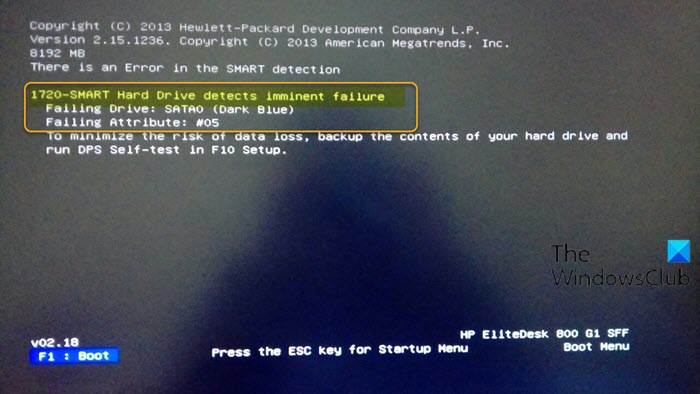The values for SATA can vary from 0, 1, 2, 4, etc. Also, the values for Attribute can vary from 05, 01, C8, 255, B8, etc. This error as indicated on the lead-in image above means that the status circuitry and firmware embedded in your drive have detected that the hard drive itself is set to fail soon, which can cause files/data loss or your hard drive will eventually stop working. Below are the potential culprits to this error:
Inconsistent temporary data.Failing drive.
1720 SMART Hard Drive detects imminent failure
If you’re faced with this issue, you can try our recommended solutions in the order presented below to resolve the issue. But before you begin, if possible, try and back up your data right away to an external hard drive. Let’s take a look at the description of the process involved concerning each of the listed solutions.
1] Clear the CMOS battery
SMART monitoring system can actually display a false positive because of cached data that’s being maintained by the CMOS (Complementary Metal-Oxide Semiconductor) battery – this is so, if you have already switched the supposedly failing drive and you’re still getting the same error. In this case, you can clear the CMOS battery and see if that helps. Do the following: You may require the services of a hardware technician.
Turn off all peripheral devices connected to the computer.Disconnect the power cord from the AC power source.Remove the computer cover.Find the battery on the board. The battery may be in a horizontal or vertical battery holder or connected to an onboard header with a wire.
If the battery is in a holder, note the orientation of the + and – on the battery. With a medium flat-blade screwdriver, gently pry the battery-free from its connector. If the battery is connected to an onboard header with a wire, disconnect the wire from the onboard header.
Wait one hour, then reconnect the battery.Put the computer cover back on.Plug the computer and all devices back in.Boot the computer.
If the booting fails with the same error, try the next solution.
2] Run CHKDSK
If the S.M.A.R.T result is a false positive, it might just be a case of bad sectors on your drive of which CHKDSK is one viable solution that can be effective to fix this issue. So, if somehow your Windows 10 computer manages to boot to the desktop, you can run CHKDSK the inbuilt tool or you can try third-party disk error checking software – but if you’re unable to boot to the desktop, and you have a spare PC, you can connect the failing drive via USB as an external drive and run the CHKDSK. If the issue still persists after running the CHKDSK operation, try the next solution.
3] Check drive health
At this point, it’s safe to assume you might be dealing with an ailing drive that is about to malfunction. However, as already pointed out, SMART monitoring is known to trigger some false positives, so we recommend you check the drive health with a 3rd-party tool like Speccy. After you must have downloaded and installed Speccy, do the following:
Launch Speccy.On the left pane of the UI, click on Storage.Next, with the Storage menu selected, on the right pane, scroll down to the Smart Attributes section.At the section, check the Status of every attribute name and see whether the status deviates from the default one (Good).
The utility will give you an overview of about 30+ SMART points that you need to look out for. If the measurements are off the normal range, you can safely conclude that the disk-drive is failing. In which case, you can proceed with the next and last solution.
4] Replace drive
At this stage, after your tests and investigations, you have concluded that the drive in question is failing – the only option right now is to get a replacement for your faulty disk drive and try to recover as many files as possible. So, if you can boot to the desktop, you can use an external drive or any available cloud storage service to back up all your important files. However, if your disk is partially damaged and you’re unable to boot to the desktop, you can either save your data/files using disk-imaging software or use a Linux Live USB to retrieve your files or you can connect the failing drive via USB as an external drive to another computer and copy out the files you need. Once you replace the failing drive and have clean installed Windows 10 on the new healthy drive, you can now proceed to restore the cloned image or just the files recovered with the USB. Hope this helps!

